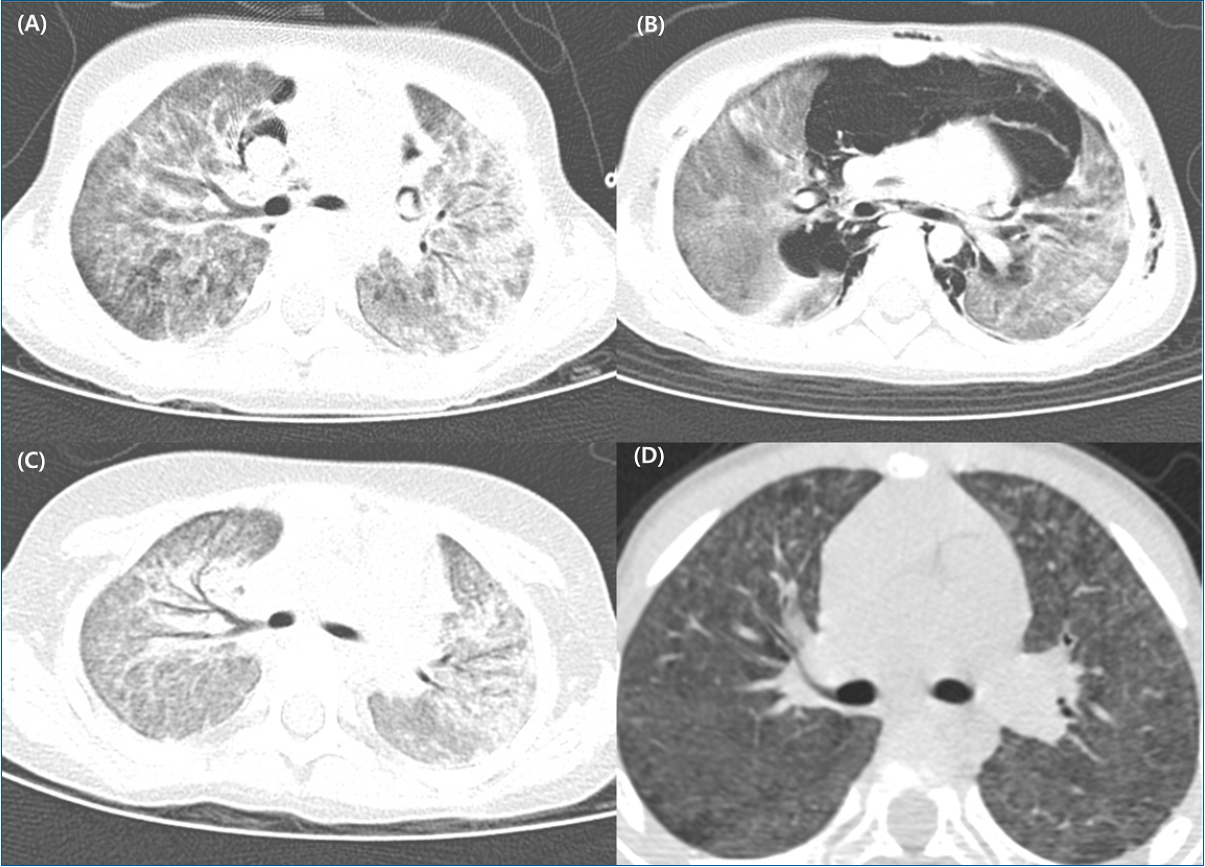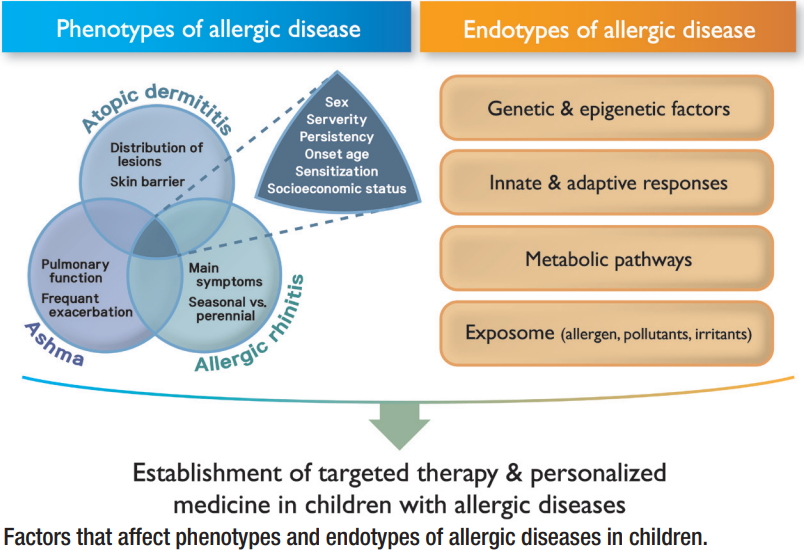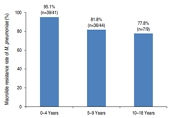Search
- Page Path
-
- HOME
- Search
- Review Article
- Pulmonology
- Evidence-based management guidelines for noncystic fibrosis bronchiectasis in children and adolescents
- Eun Lee, Kyunghoon Kim, You Hoon Jeon, In Suk Sol, Jong Deok Kim, Taek Ki Min, Yoon Ha Hwang, Hyun-Ju Cho, Dong In Suh, Hwan Soo Kim, Yoon Hee Kim, Sung-Il Woo, Yong Ju Lee, Sungsu Jung, Hyeon-Jong Yang, Gwang Cheon Jang
- Clin Exp Pediatr. 2024;67(9):418-426. Published online January 23, 2024
-

· We suggest offering long-term macrolides to children with noncystic fibrosis bronchiectasis with frequent exacerbations (conditional recommendation, moderate quality of evidence).
· We do not recommend the routine use of mucolytic agents, inhaled corticosteroids, or nonsteroidal anti-inflammatory drugs to prevent exacerbation of bronchiectasis in children (inconclusive, very low quality of evidence).
· We recommend the use of nebulized hypertonic saline to prevent exacerbations and improve the lung function of children with noncystic fibrosis bronchiectasis (weak recommendation, moderate quality of evidence).
- Original Article
- Infection
- Clinical characteristics of pediatric patients infected with SARS-CoV-2 versus common human coronaviruses: a national multicenter study
- In Suk Sol, Eun Lee, Hyeon-Jong Yang, Yong Ju Lee, Hye Yung Yum, Mi-Hee Lee, Mi Ae Chu, Hui Jeong Moon, Hyo-Bin Kim, Ju Hee Seo, Jung Yeon Shim, Ji Young Ahn, Yoon Young Jang, Hai Lee Chung, Eun Hee Chung, Kyunghoon Kim, Bong-Seong Kim, Cheol Hong Kim, Yang Park, Meeyong Shin, Kyung Suk Lee, Man Yong Han, Soo-Jong Hong, Eun Kyeong Kang, Chang Keun Kim; on behalf of The Pneumonia & Respiratory Disease Study Group of Korean Academy of Pediatric Allergy and Respiratory Disease
- Clin Exp Pediatr. 2023;66(3):134-141. Published online December 22, 2022
-

Question: The clinical differences between severe acute respiratory syndrome coronavirus-2 (SARS-CoV-2) and human coronaviruses (HCoV) in children remain unknown.
Finding: This study compared the clinical findings of children infected with SARS-CoV-2 versus HCoV. Its findings suggest that children and adolescents with SARS-CoV-2 have a milder clinical course than those with HCoV.
Meaning: The clinical course of children and adolescents with SARS-CoV-2 should be closely monitored during the coronavirus disease 2019 pandemic.
- Review Article
- Allergy
- Management of patients with allergic diseases in the era of COVID-19
- Eun Lee
- Clin Exp Pediatr. 2022;65(11):529-535. Published online September 23, 2022
-

In the early days of the coronavirus disease 2019 (COVID-19) pandemic, allergic diseases, especially asthma, were considered to be risk factors for severe COVID-19 infection, hospitalization, and death. These concerns stemmed from the idea that individuals with allergic diseases are generally more susceptible to respiratory virus infections, which are major causes of exacerbation of allergic diseases. However, epidemiologic data with...
- Pulmonology
- The past, present, and future of humidifier disinfectant-associated interstitial lung diseases in children
- Eun Lee, So-Yeon Lee, Soo-Jong Hong
- Clin Exp Pediatr. 2020;63(7):251-258. Published online December 9, 2019
-

Exposure to environmental factors can cause interstitial lung diseases (ILDs); however, such types of ILDs are rare. From 2007 to 2011, an ILD epidemic occurred in South Korea owing to inhalational exposure to toxic chemicals in humidifier disinfectants (HDs). HD-associated ILDs (HD-ILDs) are characterized by rapidly progressing respiratory failure with pulmonary fibrosis and a high mortality rate of 43.8%−58.0%. Although...
- Allergy
- Phenotypes of allergic diseases in children and their application in clinical situations
- Eun Lee, Soo-Jong Hong
- Clin Exp Pediatr. 2019;62(9):325-333. Published online April 23, 2019
-

Allergic diseases, including allergic rhinitis, asthma, and atopic dermatitis, are common heterogeneous diseases that encompass diverse phenotypes and different pathogeneses. Phenotype studies of allergic diseases can facilitate the identification of risk factors and their underlying pathophysiology, resulting in the application of more effective treatment, selection of better treatment responses, and prediction of prognosis for each phenotype. In the early phase...
- Original Article
- Pulmonology
- Prevalence and clinical manifestations of macrolide resistant
Mycoplasma pneumoniae pneumonia in Korean children - Eun Lee, Hyun-Ju Cho, Soo-Jong Hong, Jina Lee, Heungsup Sung, Jinho Yu
- Clin Exp Pediatr. 2017;60(5):151-157. Published online May 31, 2017
-

Purpose Macrolide resistance rate of
Mycoplasma pneumoniae has rapidly increased in children. Studies on the clinical features between macrolide susceptible-M. pneumoniae (MSMP) and macrolide resistant-M. pneumoniae (MRMP) are lacking. The aim of this study was to identify the macrolide resistance rate ofM. pneumoniae in Korean children withM. pneumoniae penupmonia in 2015 and compare manifestations between MSMP and MRMP.Methods Among 122...
- High degree of supervision improves adherence to inhaled corticosteroids in children with asthma
- Geun Mi Park, Hye Won Han, Hee Se Kim, Jae Youn Kim, Eun Lee, Hyun-Ju Cho, Song-I Yang, Young-Ho Jung, Soo-Jong Hong, Hyung Young Kim, Ju-Hee Seo, Jinho Yu
- Clin Exp Pediatr. 2015;58(12):472-477. Published online December 22, 2015
-
Purpose Adherence to treatment with inhaled corticosteroids (ICS) is a critical determinant of asthma control. The objective of this study was to assess factors that determine adherence to ICS therapy in children with asthma.
Methods Fifty-eight children with asthma, aged 5 to 16 years, used ICS with or without a spacer for 3 months. Adherence rates as measured from questionnaires and canisters, asthma...
- Association between cord blood 25-hydroxyvitamin D concentrations and respiratory tract infections in the first 6 months of age in a Korean population: a birth cohort study (COCOA)
- Youn Ho Shin, Jinho Yu, Kyung Won Kim, Kangmo Ahn, Seo-Ah Hong, Eun Lee, Song-I Yang, Young-Ho Jung, Hyung Young Kim, Ju-Hee Seo, Ji-Won Kwon, Byoung-Ju Kim, Hyo-Bin Kim, Jung Yeon Shim, Woo Kyung Kim, Dae Jin Song, So-Yeon Lee, Soo Young Lee, Gwang Cheon Jang, Dong In Suh, Hyeon-Jong Yang, Bong Sung Kim, Suk-Joo Choi, Soo-Young Oh, Ja-Young Kwon, Kyung-Ju Lee, Hee Jin Park, Pil Ryang Lee, Hye-Sung Won, Soo-Jong Hong
- Clin Exp Pediatr. 2013;56(10):439-445. Published online October 31, 2013
-
Purpose Previous studies suggest that the concentration of 25-hydroxyvitamin D [25(OH)D] in cord blood may show an inverse association with respiratory tract infections (RTI) during childhood. The aim of the present study was to examine the influence of 25(OH)D concentrations in cord blood on infant RTI in a Korean birth cohort.
Methods The levels of 25(OH)D in cord blood obtained from 525 Korean...
- Review Article
- Clinical efficacy and mechanism of probiotics in allergic diseases
- Ha-Jung Kim, Hyung Young Kim, So-Yeon Lee, Ju-Hee Seo, Eun Lee, Soo-Jong Hong
- Clin Exp Pediatr. 2013;56(9):369-376. Published online September 30, 2013
-
A complex interplay between genetic and environmental factors partially contributes to the development of allergic diseases by affecting development during prenatal and early life. To explain the dramatic increase in the prevalence of allergic diseases, the hygiene hypothesis proposed that early exposure to infection prevented allergic diseases. The hygiene hypothesis has changed to the microbial hypothesis, in which exposure to...
- Case Report
- Magnetic resonance imaging and spectroscopic analysis in 5 cases of Pelizaeus-Merzbacher disease: metabolic abnormalities as diagnostic tools
- Eun Lee, Mi-Sun Yum, Hae-Won Choi, Han-Wook Yoo, Su Jeong You, Eun-Hye Lee, Tae-Sung Ko
- Clin Exp Pediatr. 2012;55(10):397-402. Published online October 29, 2012
-
Pelizaeus-Merzbacher disease (PMD) is a rare, X-linked recessive disorder characterized by dysmyelination in the central nervous system. PMD results from deletion, mutation, or duplication of the proteolipid protein gene (
PLP1 ) located at Xq22, leading to the failure of axon myelination by oligodendrocytes in the central nervous system. PMD may be suspected when there are clinical manifestations such as nystagmus, developmental...
- Original Article
- Clinical characteristics and outcomes among pediatric patients hospitalized with pandemic influenza A/H1N1 2009 infection
- Eun Lee, Ju-Hee Seo, Hyung-Young Kim, Shin Na, Sung-Han Kim, Ji-Won Kwon, Byoung-Ju Kim, Soo-Jong Hong
- Clin Exp Pediatr. 2011;54(8):329-334. Published online August 31, 2011
-
Purpose The purpose of this article is to describe the clinical and epidemiologic features and outcomes among children hospitalized with pandemic influenza A/H1N1 2009 infection.
Methods We retrospectively reviewed the charts of hospitalized pediatric patients (<18 years) diagnosed with pandemic influenza A/H1N1 2009 infection by reverse-transcriptase polymerase chain reaction at a tertiary hospital in Seoul, Korea, between September 2009 and February 2010.
Results A total...
- Case Report
- A case report of chronic granulomatous disease presenting with aspergillus pneumonia in a 2-month old girl
- Eun Lee, Seak Hee Oh, Ji Won Kwon, Byoung Ju Kim, Jinho Yu, Chan Jeoung Park, Soo Jong Hong
- Clin Exp Pediatr. 2010;53(6):722-726. Published online June 23, 2010
-
Chronic granulomatous disease (CGD) is an uncommon inherited disorder caused by mutations in any of the genes encoding subunits of the superoxide-generating phagocyte NADPH oxidase system, which is essential for killing catalase producing bacteria and fungi, such as
Aspergillus species,Staphylococcus aureus ,Serratia marcescens ,Nocardia species andBurkholderia cepacia . In case of a history of recurrent or persistent infections, immune...
- A Case of Rickets Developed after Feeding on Sunsik for Seven Months
- Jeong-A Yang, Kyung-A Jang, Hye-Won Park, Wook Jang, Man-Yong Han, Young-A Cho, Eun Lee
- Clin Exp Pediatr. 2003;46(11):1143-1146. Published online November 15, 2003
-
Rickets is a nutritional disorder which is caused either by deficiency of vitamin D or by a defective activation of vitamin D. In these days, even though the incidence of rickets has decreased through adequate nutritional support, we sometimes experience rickets in babies receiving a prolonged special diet as therapy for chronic diarrhea, or those subject to a in receiving... -
-

-
-
Impact Factor3.2
-
8.02023CiteScore94th percentilePowered by
-









